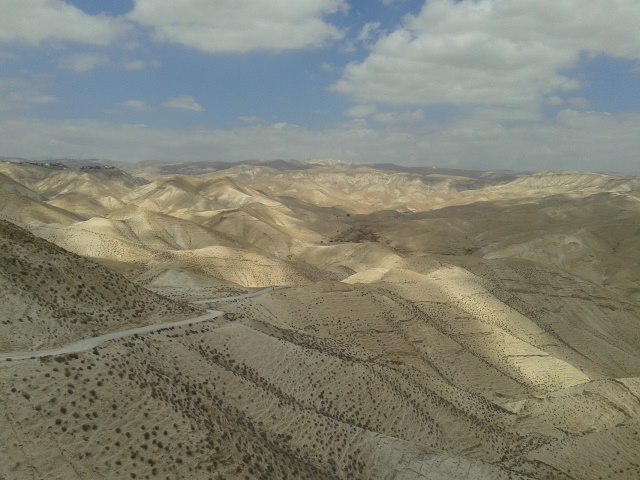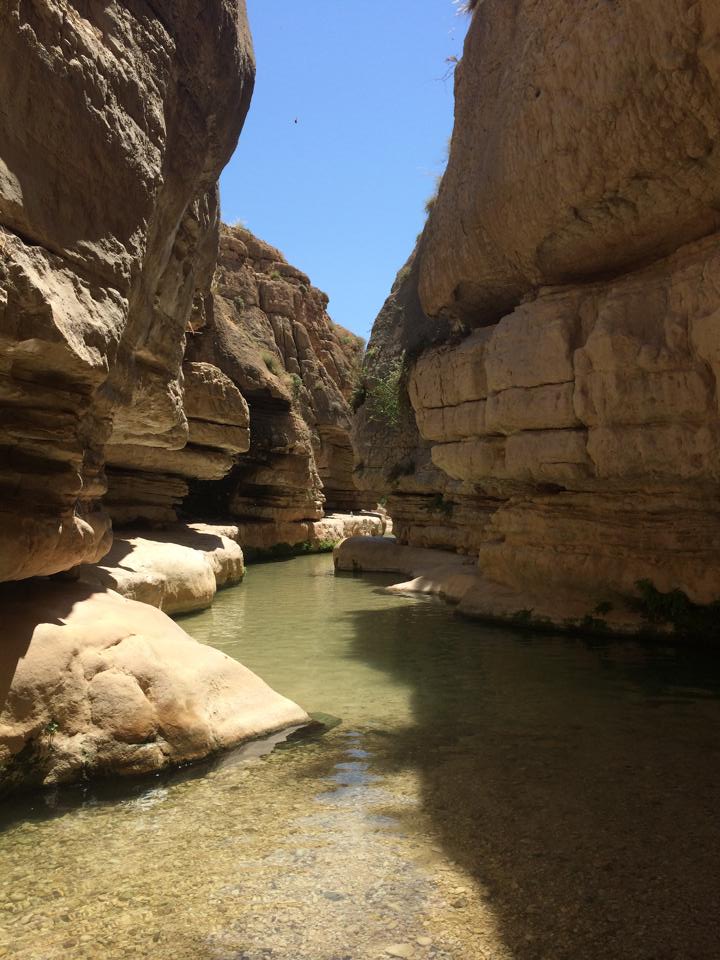Wadi Qelt, also known as the Prat River, is a beautiful oasis of waterfalls and towering rocks, located deep inside the Jordan Valley, just outside the West Bank city of Jericho. Impossibly hot in the summer and suffering from flash floods in the winter it is not always possible to hike in the region.
In addition to offering a variety of hiking routes, there is a great depth of religious history to be found in the Wadi (valley). The route passes one of the oldest synagogues in the world, and St. George’s Monastery, one of the oldest continuously active Greek Orthodox monestaries. There are also ancient aqueducts and ruins along the valley, with some dating from the 2nd century BC, during the Hasmonean period.
Wadi Qelt is located in Area C, which is controlled entirely by the Israeli military. After the Oslo Accords in 1994, the West Bank was divided into three areas, with the view to concede all land to the Palestinian Authority (PA) after five years. Area A, constitutes the main cities (Ramallah, Bethlehem, Nablus, Hebron, Qalqilya, Tulkarem, and Jenin), and is controlled entirely by the PA. Area B, which constitutes the areas surrounding the cities is controlled by both the Israeli military and the Palestinian Authority; civilian matters are controlled by the PA, while security issues are under the jurisdiction of the Israeli’s. Together, area A and B make up only 38% of the West Bank. This leaves the remaining 62% of the West Bank under complete Israeli military control1
Palestinians are able to travel throughout the West Bank, though they are forbidden from entering Israeli settlements. However, driving from Jerusalem to Wadi Qelt, you pass a number of checkpoints, some permanent and some temporary; checkpoints that exist for maybe only half an hour and are then moved. Checkpoints seriously inhibit Palestinians movement around areas B and C of the West Bank; many Palestinians are often forbidden from passing checkpoints, and are interrogated or delayed, making movement around the West Bank increasingly difficult.
 Furthermore Palestinians must take roads that skirt around the many illegal Israeli settlements that exist in the West Bank, making journey times up to twice as long.
Furthermore Palestinians must take roads that skirt around the many illegal Israeli settlements that exist in the West Bank, making journey times up to twice as long.
Although today both Israelis and Palestinians frequent the trails in Wadi Qelt with few incidents, historically it was a place of violence. In 1968, an Israeli lieutenant was killed in action while pursuing Arabs who had crossed from Jordan. In the years following the 1993 Declaration of Principles, several attacks were made on Israeli hikers for political reasons.
Many Palestinian Bedouins live in the caves located in the steep rock faces of the valley, and regularly herd their sheep and goats through the valley. Together with Israeli settlers, international tourists come to enjoy the waterfalls and swimming spots along the way, and although there is almost always water in Wadi Qelt, the situation in other parts of the Jordan Valley is very different.
Most of the communities living in the Jordan Valley suffer from a lack of water, needed for both themselves and for their animals, due to Israeli control of water resources. Palestinians are permitted to use only approximately 40% of the water located in the Jordan Valley. Settlers use about six and half times more water than the 56’000 Palestinian residents. Furthermore, Palestinian communities are often forced to use contaminated water that has run off from nearby settlements and Israeli owned factories.
 Despite the surrounding politics of the region Wadi Qelt is a desert oasis, where both Palestinians and Israeli’s can enjoy the natural water resources and adventurous hikes. The scenery is also incredible, you are walking below rocks filled with caves, many of them home to local Bedouin.
Despite the surrounding politics of the region Wadi Qelt is a desert oasis, where both Palestinians and Israeli’s can enjoy the natural water resources and adventurous hikes. The scenery is also incredible, you are walking below rocks filled with caves, many of them home to local Bedouin.
There is also ample flora and fauna, as well as pomegranate trees and fresh spearmint growing. Wadi Qelt is for adventurous hikers who can handle terrain of medium difficulty. You will be climbing over boulders and wading through water, and while the hike isn’t more than three hours long, you will need to have a degree of flexibility to get through cracks and over the boulders.
Bring lots of water, a picnic, your swimming stuff, and make sure you have good sturdy shoes for a great day out all year round.
References:
1 http://unispal.un.org/UNISPAL.NSF/0/59AE27FDECB034BD85257793004D5541
2 http://www.jordanvalleysolidarity.org/index.php/info-maps-2/water-rights
3 http://www.savethechildren.org.uk/en/docs/English_Jordan_Valley_Fact_Sheet_and_Citations.pdf
Route:
From Jerusalem, go to Azza Street (near Jerusalem Theatre), and take bus number 19 towards Hebrew University Mount Scopus. From here take bus number 216 towards Dvir/Reserve blocks. Get off the bus at Up Ariel (on Ma’ale Ari’el St.), from here it is a 1⁄2 hour walk to the beginning of the valley. Buses are fairly regular, coming twice an hour.
From Ramallah, take a service towards Jericho, asking the driver to drop you off at the entrance to Wadi Qelt. You’ll have to cross the road, where on the right there will be the entrance to a settlement and on your left a gas station. Take the left (there is a sign saying Wadi Qelt) and keep walking towards the valley, it’s about a ten minute walk. You then start walking down a dirt road and eventually get to the monastery. Take the road and stairs to the left of the monastery, and then path becomes clear. You will then get to a body of water – take off your shoes and go to the end. Here is where it looks momentarily like there is no path. Spend the next ten minutes scrambling over the rocks and you will find the marked path again, continue along it for the next two hours, there are lots of spots along the way to take a rest. You will know you are at the end when you get to a shop with 3 flags. From here you can get a lift back to Ramallah.
Find more routes in Wadi Qelt, as well as around the West Bank, in Walking Palestine, by Stefan Szepesi.
Hannah Barkan is an intern journalist living in Ramallah, Palestine. She has had her work published on Palestine Monitor and Europe Café. When not interning or writing, she can be found exploring the great outdoors of Palestine and looking for niche swimming spots.


Customer
Viagra generico online https://motocom.co/demos/netw5/askme/question/canadian-pharmaceuticals-online-5/
Appreciate it, An abundance of posts!
Customer
Viagra 5mg https://sanangelolive.com/members/thisphophehand
You made your point quite clearly.!
Customer
Viagra coupon https://tropkefacon.estranky.sk/clanky/buy-ivermectin-fitndance.html
Many thanks, A good amount of data!
Customer
stromectol drug https://theosipostmouths.estranky.cz/clanky/stromectol-biam.html
Info effectively regarded!.
Customer
Viagra vs viagra https://challonge.com/bunmiconglours
You actually revealed that well.
Customer
Generic for viagra https://www.provenexpert.com/medicament-stromectol/
You have made your position quite well!!
Customer
Viagra lowest price https://pinshape.com/users/2491694-buy-stromectol-fitndance
You expressed it well.
Customer
buy ivermectin fitndance https://aoc.stamford.edu/profile/cliclecnotes/
Cheers. I enjoy it!
Customer
Viagra rezeptfrei https://reallygoodemails.com/orderstromectoloverthecounterusa
Appreciate it, Quite a lot of facts.
Customer
Canadian viagra https://feeds.feedburner.com/bing/stromectolnoprescription
You expressed this adequately!
Customer
Viagra for daily use https://canadianpharmaceuticalsonline.as.me/schedule.php
You explained this wonderfully.
Customer
online pharmacies https://results.excite.com/serp?q=“My Canadian Pharmacy – Extensive Assortment of Medications – 2022”
Thanks a lot. A good amount of facts!
Customer
Viagra alternative https://headwayapp.co/canadianppharmacy-changelog
Thank you, A lot of knowledge!
Customer
Viagra generic https://www.infospace.com/serp?q=“My Canadian Pharmacy – Extensive Assortment of Medications – 2022”
Thanks, Numerous forum posts.
Customer
Viagra or viagra https://results.excite.com/serp?q=“My Canadian Pharmacy – Extensive Assortment of Medications – 2022”
Great info, Appreciate it!
Customer
Viagra bula
Really plenty of superb information!
Customer
online pharmacies canada https://www.bakespace.com/members/profile/Сanadian pharmaceuticals for usa sales/1541108/
Superb posts. Cheers.
Customer
5 mg viagra coupon printable https://search.givewater.com/serp?q=“My Canadian Pharmacy – Extensive Assortment of Medications – 2022”
Kudos, Ample postings.
Customer
canadian pharmacies shipping to usa
Great info, Appreciate it!
Customer
Viagra 20 mg https://www.dogpile.com/serp?q=“My Canadian Pharmacy – Extensive Assortment of Medications – 2022”
Nicely put. Thanks.
Customer
Viagra rezeptfrei https://swisscows.com/en/web?query=“My Canadian Pharmacy – Extensive Assortment of Medications – 2022”
You actually mentioned it adequately.
Customer
Online viagra
With thanks. I enjoy this!
Customer
ivermectina dosis https://sanangelolive.com/members/unsafiri
Factor very well used!!
Customer
canadian online pharmacies https://search.seznam.cz/?q=“My Canadian Pharmacy – Extensive Assortment of Medications – 2022”
Amazing a lot of good data!
Customer
Viagra generika https://search.gmx.com/web/result?q=“My Canadian Pharmacy – Extensive Assortment of Medications – 2022”
Point effectively utilized!.
Customer
Viagra reviews https://www.giantbomb.com/profile/canadapharmacy/blog/canadian-pharmaceuticals-online/265652/
Whoa a good deal of good info.
Customer
Viagra manufacturer coupon https://seedandspark.com/user/canadian-pharmaceuticals-online
You have made your position pretty well.!
Customer
Viagra 5mg https://www.ecosia.org/search?q=“My Canadian Pharmacy – Extensive Assortment of Medications – 2022”
Info effectively considered..
Customer
stromectol for sale online https://sanangelolive.com/members/girsagerea
Nicely put. Cheers.
Customer
Viagra great britain https://sanangelolive.com/members/canadianpharmaceuticalsonlineusa
You have made the point!
Customer
Tadalafil https://www.audiologysolutionsnetwork.org/profile/422019/0
Seriously tons of superb facts!
Customer
canada viagra https://moaamein.nacda.com/profile/422018/0
You’ve made the point.
Customer
Buy generic viagra https://legalmarketplace.alanet.org/profile/421920/0
Fine data. Many thanks.
Customer
Viagra daily https://wefbuyersguide.wef.org/profile/421914/0
Nicely put, With thanks.
Customer
Viagra vs viagra https://supplier.ihrsa.org/profile/421717/0
With thanks! Loads of posts!
Customer
Viagra canada https://www.myscrsdirectory.com/profile/421708/0
You actually stated this very well.
Customer
buy ivermectin fitndance https://inflavnena.zombeek.cz/
Incredible lots of amazing tips!
Customer
How does viagra work https://dsdgbvda.zombeek.cz/
Excellent knowledge. Regards.
Customer
Viagra bula https://lehyriwor.estranky.sk/clanky/stromectol-cream.html
You explained this terrifically.
Customer
Viagra 5 mg funziona https://soncheebarxu.estranky.cz/clanky/stromectol-for-head-lice.html
Thanks, I like it!
Customer
How does viagra work https://order-stromectol-over-the-counter.estranky.cz/clanky/order-stromectol-over-the-counter.html
You actually expressed this perfectly.
Customer
Viagra bula https://challonge.com/citlitigolf
Kudos, Fantastic stuff!
Customer
Viagra alternative https://challonge.com/gotsembpertvil
Thanks! A lot of advice.
Customer
Viagra 5mg prix https://challonge.com/esapenti
With thanks! Lots of stuff!
Customer
northwest pharmacies https://slides.com/canadianpharmaceuticalsonline
Info certainly considered!.
Customer
How does viagra work https://experiment.com/users/canadianpharmacy
Amazing loads of wonderful facts.
Customer
Viagra 20 mg https://buyersguide.americanbar.org/profile/420642/0
You actually expressed this effectively.
Customer
Viagra 5mg https://haikudeck.com/canadian-pharmaceuticals-online-personal-presentation-827506e003
Superb posts. Cheers.
Customer
Generic viagra https://melaninterest.com/user/canadian-pharmaceuticals-online/?view=likes
Thanks! Lots of info!
Customer
Viagra coupon https://sanangelolive.com/members/pharmaceuticals
Appreciate it, Numerous info.